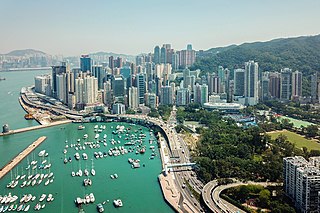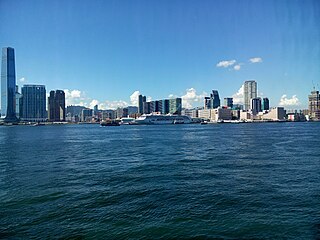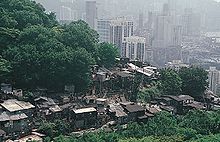
Causeway Bay is an area and a bay on Hong Kong Island, Hong Kong, straddling the border of the Eastern and the Wan Chai districts. It is a major shopping, leisure and cultural centre in Hong Kong, with a number of major shopping centres. The rents in the shopping areas of Causeway Bay were ranked as the world's most expensive for the second year in a row in 2013, after overtaking New York City's Fifth Avenue in 2012. When referring to the area, the Cantonese name is never written in English as "Tung Lo Wan".

Kowloon is an urban area in Hong Kong comprising the Kowloon Peninsula and New Kowloon. It has a population of 2,019,533 and a population density of 43,033/km2 (111,450/sq mi) in 2006. It is one of the three areas of Hong Kong, along with Hong Kong Island and the New Territories. It is the smallest, second most populous and most densely populated of the divisions.
Hong Kong has a long coastline that is full of twists and turns with many bays and beaches. Many of them are well sheltered by mountains nearby, as Hong Kong is a mountainous place. As a result, large waves seldom appear at the bays, making them suitable for human swimming.
Hong Kong counts approximately 600 temples, shrines and monasteries. While Buddhism and Christianity are the most widely practiced religions, most religions are represented in the Special Administrative Region.

Telephone numbers in Hong Kong are mostly eight-digit. Fixed land line numbers start with 2 or 3, mobile (cellular) phone numbers with 4, 5, 6, 7, 8, or 9, pager numbers with 7 and forwarding service with 8. Since the end of 1989, there have been no area codes within Hong Kong.

Sham Shui Po District is one of 18 districts of Hong Kong. It is the second poorest district by income in Hong Kong, with a predominantly working-class population of 405,869 in 2016 and the lowest median household income of all districts. Sham Shui Po has long been home to poorer new immigrants from China. It also saw the birth of public housing in Hong Kong, as the government sought to resettle those displaced by a devastating fire in its slums. Sham Shui Po also hosted a Vietnamese refugee camp during the influx of migration in the aftermath of the Vietnam War in the 1970s.

The Lunar New Year Fair, also known as the flower market, is a type of fair held annually a few days before Lunar New Year in Chinese New Year markets in China. These fairs are primarily practiced by the Cantonese, and spread with Cantonese immigration.
A Site of Special Scientific Interest or SSSI is a special area to protect wildlife, habitats and geographic features based on scientific interest in Hong Kong. Scientific interests are special features relating to animal life, plant life, geology and/or geography. After being identified by the Agriculture, Fisheries and Conservation Department, these areas are documented by the Planning Department and added to maps. From 1975 to 2005, 67 locations were designated SSSIs throughout Hong Kong.

Tung Lo Wan Road is a road in Causeway Bay and Tai Hang on the north side of Hong Kong Island in Hong Kong. The road joins east with King's Road, Tin Hau Temple Road, Causeway Road and west with Yee Wo Street, Irving Street, Leighton Road and Causeway Road.

Tai Hang Road is a major road on the north side of Hong Kong Island in Hong Kong. Starting low from Tai Hang at Tung Lo Wan Road, Causeway Bay, it winds up to So Kon Po and further up to the mid-levels of Jardine's Lookout and Mount Nicholson, passing through Wong Nai Chung Gap. There are a number of luxurious residential apartments along this road such as Illumination Terrace, Grand Deco Tower and The Legend.

Lai Tak Tsuen is a public housing estate at 2 – 38 Lai Tak Tsuen Road, Tai Hang, Causeway Bay, Hong Kong. Built in 1975, it is one of the first public housing developments in Hong Kong. It was the second self-funded rental project of the Hong Kong Housing Society. The housing estate was named after a Hong Kong government officer, Michael Wright, who had served the Government of Hong Kong for more than 30 years.
Articles related to Hong Kong include:

Lin Fa Temple or Lin Fa Kung is a temple located at the end of Lin Fa Kung Street, which is named after the temple, in the Tai Hang area in the southeastern part of Causeway Bay, Hong Kong Island. It was originally built in 1863, during the Qing dynasty, and was reconstructed in 1986 and 1999. The original use of the temple was a worship place for Guanyin, the goddess of mercy.















